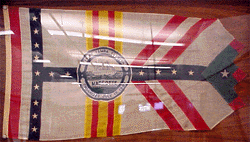Until 1930, the City of Tampa had no flag. In June of that year a local industrial engineer presented Mayor D. B. McKay with his original design symbolizing the city's multi-national heritage. McKay, in turn, presented the banner to the Board of Representatives and recommended that it be adopted as the official flag of the City. Meeting on July 1, 1930, the Board acted favorably on the recommendation. One week later during a session of the Board, Mayor McKay publicly and officially accepted the flag from its designer, F. Grant Whitney.

Red, white, and blue for the Stars and Stripes, the red and gold of Spain, the British Union Jack, the red, white and green of Italy and the French tricolor were used to portray the countries that contributed to the growth of Florida.
Spain's role in the development of Tampa begins with the initial Spanish exploration of the Tampa Bay area in 1528. Spain's colors of red and gold signify their importance in Tampa's history.
In 1763, England purchased Florida from Spain and a lengthy period of British influence began. Both colonization and commerce were encouraged by the British and the population of the Tampa Bay area grew considerably until, in 1821, the United States purchased Florida. British contribution to Tampa is denoted by the Union Jack and portions of the Crosses of St. Andrew and St. George; the state is acknowledged both by the red, white and red stripe of its flag and by the letter "F".
As an American territory, Florida -- and the town of Tampa -- flourished. Fort Brooke was established and, in 1834, the Territorial Legislature created Hillsborough County, which is symbolized by a stylized "H".
The official seal of the City of Tampa, superimposed on a blue "T", commemorates the official birth of the City of Tampa in 1855.
